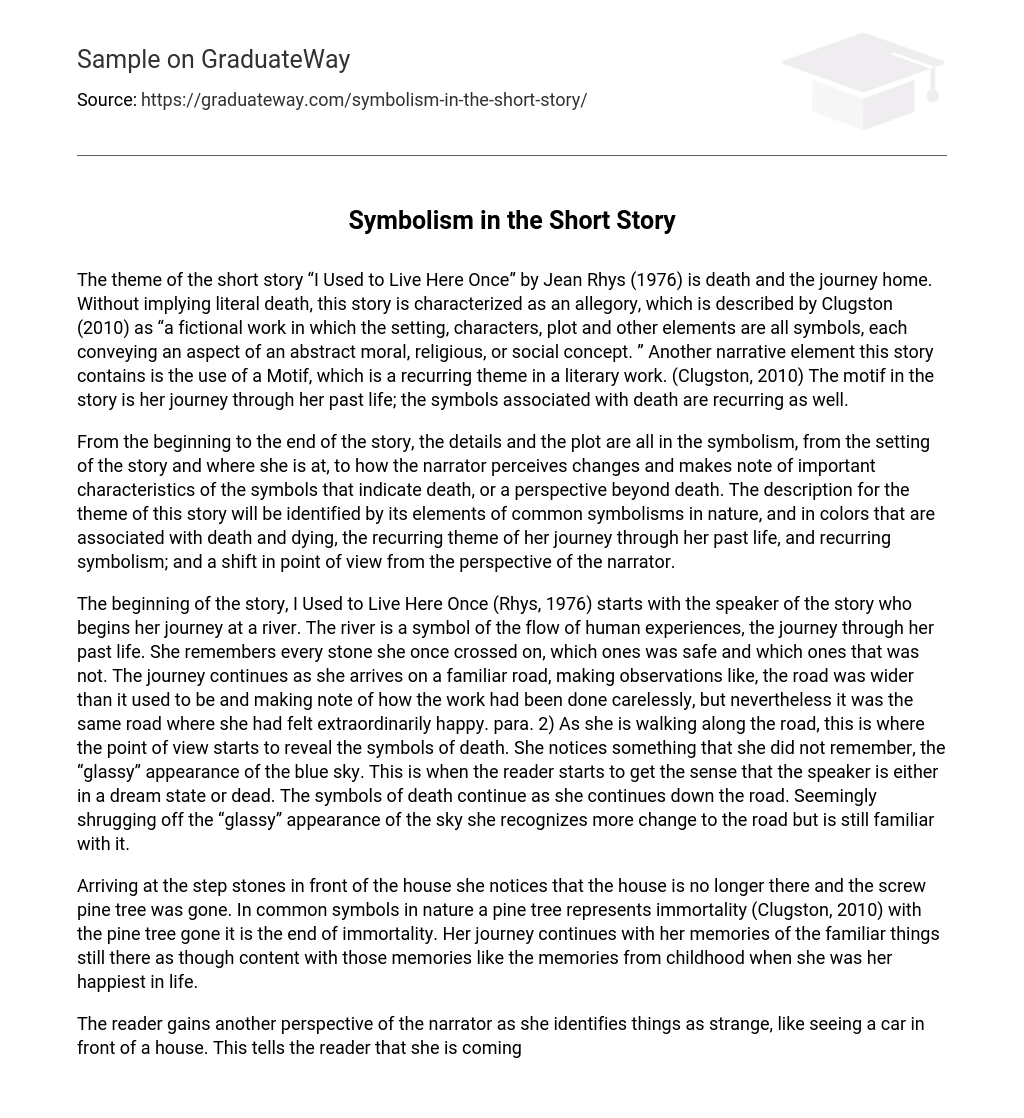The theme of the short story “I Used to Live Here Once” by Jean Rhys (1976) is death and the journey home. Without implying literal death, this story is characterized as an allegory, which is described by Clugston (2010) as “a fictional work in which the setting, characters, plot and other elements are all symbols, each conveying an aspect of an abstract moral, religious, or social concept. ” Another narrative element this story contains is the use of a Motif, which is a recurring theme in a literary work. (Clugston, 2010) The motif in the story is her journey through her past life; the symbols associated with death are recurring as well.
From the beginning to the end of the story, the details and the plot are all in the symbolism, from the setting of the story and where she is at, to how the narrator perceives changes and makes note of important characteristics of the symbols that indicate death, or a perspective beyond death. The description for the theme of this story will be identified by its elements of common symbolisms in nature, and in colors that are associated with death and dying, the recurring theme of her journey through her past life, and recurring symbolism; and a shift in point of view from the perspective of the narrator.
The beginning of the story, I Used to Live Here Once (Rhys, 1976) starts with the speaker of the story who begins her journey at a river. The river is a symbol of the flow of human experiences, the journey through her past life. She remembers every stone she once crossed on, which ones was safe and which ones that was not. The journey continues as she arrives on a familiar road, making observations like, the road was wider than it used to be and making note of how the work had been done carelessly, but nevertheless it was the same road where she had felt extraordinarily happy. para. 2) As she is walking along the road, this is where the point of view starts to reveal the symbols of death. She notices something that she did not remember, the “glassy” appearance of the blue sky. This is when the reader starts to get the sense that the speaker is either in a dream state or dead. The symbols of death continue as she continues down the road. Seemingly shrugging off the “glassy” appearance of the sky she recognizes more change to the road but is still familiar with it.
Arriving at the step stones in front of the house she notices that the house is no longer there and the screw pine tree was gone. In common symbols in nature a pine tree represents immortality (Clugston, 2010) with the pine tree gone it is the end of immortality. Her journey continues with her memories of the familiar things still there as though content with those memories like the memories from childhood when she was her happiest in life.
The reader gains another perspective of the narrator as she identifies things as strange, like seeing a car in front of a house. This tells the reader that she is coming from a childhood perspective, like cars had not been invented yet, and that the speaker must be very old. The story continues with more symbols like the yellow grass in the hot sunlight (para. 6) the color yellow in common symbolism represents decay and aging. (Clugston, 2010) This is probably the turning point where the speaker is starting to realize her own death.
She sees some children and begins to call out to them, they do not hear her, as she draws closer to them, and she feels a longing to touch them. She is looking right at the little boy who does not see her but he makes a comment that he feels cold all of the sudden, and asks the little girl if she feels cold also. She agrees and they go inside. The sudden cold is the final symbol of death in the story. It was a hot summer day so it was not a likely event that the children could suddenly be cold. This is when the speaker realizes finally that she is dead.
The description for the theme of this story has been identified as death and the journey home by its elements of common symbolisms in nature, and in colors, that are associated with death and dying, like the pine tree which symbolizes immortality but it is missing, the yellow grass which symbolizes decay and aging; the sudden cold feeling on a hot summer day which commonly symbolizes the presence of a ghost; the reoccurring theme of her journey home through her past life, and a shift in point of view from the perspective of the narrator to going from a dreamlike state to recognizing her own death by observing the children getting cold suddenly in her presence, and the final line of the story stating “That was the first time she knew. ” References Rhys, J (1976) I Used to Live Here Once found in Clugston, R (2010) Journey into Literature Retrieved from:https://content. ashford. edu/books/AUENG125. 10. 2/sections/ch07. Bridgepoint Education, Inc. San Diego, Ca.





